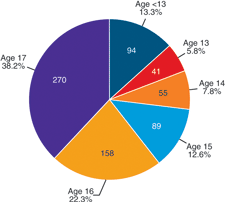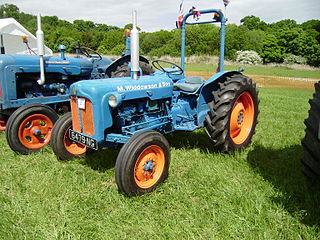The Occupational Safety and Health Administration is a large regulatory agency of the United States Department of Labor that originally had federal visitorial powers to inspect and examine workplaces. The United States Congress established the agency under the Occupational Safety and Health Act, which President Richard M. Nixon signed into law on December 29, 1970. OSHA's mission is to "assure safe and healthy working conditions for working men and women by setting and enforcing standards and by providing training, outreach, education, and assistance." The agency is also charged with enforcing a variety of whistleblower statutes and regulations. OSHA's workplace safety inspections have been shown to reduce injury rates and injury costs without adverse effects on employment, sales, credit ratings, or firm survival.

The Occupational Safety and Health Act of 1970 is a US labor law governing the federal law of occupational health and safety in the private sector and federal government in the United States. It was enacted by Congress in 1970 and was signed by President Richard Nixon on December 29, 1970. Its main goal is to ensure that employers provide employees with an environment free from recognized hazards, such as exposure to toxic chemicals, excessive noise levels, mechanical dangers, heat or cold stress, or unsanitary conditions. The Act created the Occupational Safety and Health Administration (OSHA) and the National Institute for Occupational Safety and Health (NIOSH).

A work accident, workplace accident, occupational accident, or accident at work is a "discrete occurrence in the course of work" leading to physical or mental occupational injury. According to the International Labour Organization (ILO), more than 337 million accidents happen on the job each year, resulting, together with occupational diseases, in more than 2.3 million deaths annually.

An occupational injury is bodily damage resulting from working. The most common organs involved are the spine, hands, the head, lungs, eyes, skeleton, and skin. Occupational injuries can result from exposure to occupational hazards, such as temperature, noise, insect or animal bites, blood-borne pathogens, aerosols, hazardous chemicals, radiation, and occupational burnout.
Construction site safety is an aspect of construction-related activities concerned with protecting construction site workers and others from death, injury, disease or other health-related risks. Construction is an often hazardous, predominantly land-based activity where site workers may be exposed to various risks, some of which remain unrecognized. Site risks can include working at height, moving machinery and materials, power tools and electrical equipment, hazardous substances, plus the effects of excessive noise, dust and vibration. The leading causes of construction site fatalities are falls, electrocutions, crush injuries, and caught-between injuries.
Contingent work, casual work, or contract work, is an employment relationship with limited job security, payment on a piece work basis, typically part-time that is considered non-permanent. Although there is less job security, freelancers often report incomes higher than their former traditional jobs.
The Michigan Occupational Safety and Health Administration (MIOSHA) is a state government agency that regulates workplace safety and health in the U.S. state of Michigan. Michigan OSHA is an agency within the Michigan Department of Licensing and Regulatory Affairs and operates under a formal state-plan agreement with the Occupational Safety and Health Administration (OSHA).

Workplace violence (WPV), violence in the workplace (VIW), or occupational violence refers to violence, usually in the form of physical abuse or threat, that creates a risk to the health and safety of an employee or multiple employees. The National Institute for Occupational Safety and Health defines worker on worker, personal relationship, customer/client, and criminal intent all as categories of violence in the workplace. These four categories are further broken down into three levels: Level one displays early warning signs of violence, Level two is slightly more violent, and level three is significantly violent. Many workplaces have initiated programs and protocols to protect their workers as the Occupational Health Act of 1970 states that employers must provide an environment in which employees are free of harm or harmful conditions.

An occupational hazard is a hazard experienced in the workplace. This encompasses many types of hazards, including chemical hazards, biological hazards (biohazards), psychosocial hazards, and physical hazards. In the United States, the National Institute for Occupational Safety and Health (NIOSH) conduct workplace investigations and research addressing workplace health and safety hazards resulting in guidelines. The Occupational Safety and Health Administration (OSHA) establishes enforceable standards to prevent workplace injuries and illnesses. In the EU, a similar role is taken by EU-OSHA.

Around the world, nearly 250 million children, about one in every six children, ages 5 through 17, are involved in child labor. Children can be found in almost any economic sector. However, at a global level, most of them work in agriculture (70%). Approximately 2.4 million adolescents aged 16 to 17 years worked in the U.S. in 2006. Official employment statistics are not available for younger adolescents who are also known to work, especially in agricultural settings.
Workplace health surveillance or occupational health surveillance (U.S.) is the ongoing systematic collection, analysis, and dissemination of exposure and health data on groups of workers. The Joint ILO/WHO Committee on Occupational Health at its 12th Session in 1995 defined an occupational health surveillance system as "a system which includes a functional capacity for data collection, analysis and dissemination linked to occupational health programmes".
An occupational fatality is a death that occurs while a person is at work or performing work related tasks. Occupational fatalities are also commonly called "occupational deaths" or "work-related deaths/fatalities" and can occur in any industry or occupation.
The Fatality Assessment and Control Evaluation (FACE) program's goal is the prevention of occupational fatality. Program elements include:

A physical hazard is an agent, factor or circumstance that can cause harm with contact. They can be classified as type of occupational hazard or environmental hazard. Physical hazards include ergonomic hazards, radiation, heat and cold stress, vibration hazards, and noise hazards. Engineering controls are often used to mitigate physical hazards.

Occupational safety and health (OSH) or occupational health and safety (OHS), also known simply as occupational health or occupational safety, is a multidisciplinary field concerned with the safety, health, and welfare of people at work. These terms also refer to the goals of this field, so their use in the sense of this article was originally an abbreviation of occupational safety and health program/department etc. OSH is related to the fields of occupational medicine and occupational hygiene.

People who are driving as part of their work duties are an important road user category. First, workers themselves are at risk of road traffic injury. Contributing factors include fatigue and long work hours, delivery pressures, distractions from mobile phones and other devices, lack of training to operate the assigned vehicle, vehicle defects, use of prescription and non-prescription medications, medical conditions, and poor journey planning. Death, disability, or injury of a family wage earner due to road traffic injury, in addition to causing emotional pain and suffering, creates economic hardship for the injured worker and family members that may persist well beyond the event itself.
There are a number of occupational hazards of grain facilities. These hazards can be mitigated through diligence and following proper safety procedures. Grain Facility Occupation Exposure is the quantifiable expression of workplace health and safety hazards a grain-handling facility employee is vulnerable to in performing their assigned duties. Exposure represents the probability that a given hazard will have some level of effect of a receptor of interest. This page utilizes data and information regarding grain facility occupational exposure in the United States.

Agricultural safety and health is an aspect of occupational safety and health in the agricultural workplace. It specifically addresses the health and safety of farmers, farm workers, and their families.

Workplace robotics safety is an aspect of occupational safety and health when robots are used in the workplace. This includes traditional industrial robots as well as emerging technologies such as drone aircraft and wearable robotic exoskeletons. Types of accidents include collisions, crushing, and injuries from mechanical parts. Hazard controls include physical barriers, good work practices, and proper maintenance.
The Census of Fatal Occupational Injuries, or the CFOI Program is a Federal/State cooperative program that publishes data on fatal cases of work-related injuries for all States, Territories, and New York City. The CFOI has detailed information on those who died at work due to a traumatic injury. CFOI data include all fatalities that occurred in the reference year that were the result of a workplace injury, regardless of when the injury occurred.












